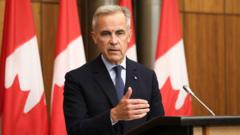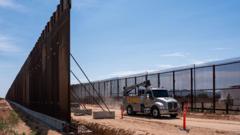The doubling of tariffs on steel and aluminum imports to 50% by President Trump has raised eyebrows across the globe. While the administration aims to bolster the U.S. steel industry, critics voice concerns over negative impacts on U.S. manufacturers, rising costs, and potential trade retaliations from affected countries, highlighting a contentious path ahead for U.S. trade policy.
U.S. Steel and Aluminum Tariffs Reach 50%: A Double-Edged Sword

U.S. Steel and Aluminum Tariffs Reach 50%: A Double-Edged Sword
President Trump's recent decision to double steel and aluminum tariffs from 25% to 50% sparks widespread debate on its economic implications and potential retaliatory measures from trade partners.
President Donald Trump has officially doubled tariffs on steel and aluminum imports from 25% to 50%, marking a significant escalation in his trade policy. The new tariffs, effective from Wednesday, are aimed at protecting the American steel industry but have incited criticism over their broader economic repercussions and potential responses from international trade partners.
This sharp increase comes less than a year after initially imposing a 25% tariff on steel and 10% on aluminum. Trump has justified these tariffs by invoking a law that allows protecting industries considered essential to national security. However, concerns have been raised about the retaliatory measures from countries exporting metals to the U.S., particularly Canada, Brazil, Mexico, and South Korea, who may face crippling consequences from this protectionist approach.
Industries using these key inputs in their production processes are already feeling the effects. Rick Huether, CEO of Independent Can Co., expressed anxiety over the chaos these abrupt policy changes could cause, with potential shifts towards alternative materials such as paper and plastic threatening his business. As the U.S. continues to be the world's largest importer of steel, analysts anticipate that the immediate consequence will be supplier costs skyrocketing.
While Trump's past tariffs initially led to a short-term creation of jobs in the steel sector, economists warn of greater job losses in other industries, projecting that doubling down on these tariffs could exacerbate such negative effects. The Tax Foundation's Erica York cited studies indicating that tariffs on intermediate goods like steel and aluminum can significantly hinder production, ultimately harming the economy at large.
In Europe, reaction has been swift, with the European Commission confirming that discussions are underway to respond to the tariff increases. The situation poses challenges to ongoing trade negotiations, as the U.K. successfully secured a carve-out that preserves its existing 25% tariffs, igniting expectations for the ongoing talks to shield British interests.
The new tariff regime spells potential disaster for UK steel exports, representing around 7% of overall exports to the U.S. Industry representatives fear that the resulting complexities and elevated costs could lead to order cancellations and significant financial losses.
Furthermore, companies that depended on competitively priced foreign steel are already feeling the pressure of impending price hikes, as demonstrated by Chad Bartusek's family-owned manufacturing firm in Illinois, which anticipates its tariffs nearly doubling.
As Trump continues to advocate for stringent tariffs, posing the notion that a 50% rate will protect American industries, opposition from within economic and manufacturing sectors suggests a critical need for a reevaluation of such trade policy. Moving forward, stakeholders remain vigilant, expecting the reverberations from these tariffs to shape an uncertain trading landscape both domestically and globally.




















